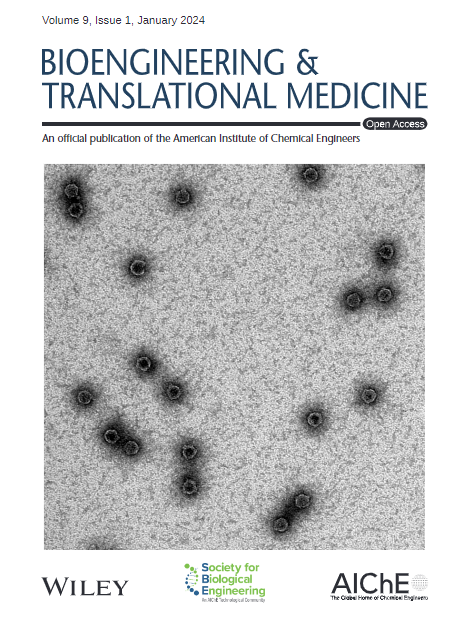Decellularized lymph node scaffolds accelerate restoration of lymphatic drainage in rat hind limb lymphedema
IF 5.7
2区 医学
Q1 ENGINEERING, BIOMEDICAL
引用次数: 0
Abstract
BackgroundThere is a lack of effective lymphedema prevention methods. The objective of this study was to investigate the ability of decellularized lymph nodes (dLNs) transplantation to prevent hindlimb lymphedema.MethodsPorcine dLNs were prepared using 1% sodium dodecyl sulfate and 1% Triton X‐100, and the effectiveness of decellularization was assessed by histological assessment and DNA quantification. Lymph node (LN) fragments and dLNs were transplanted into mice, and samples were collected for evaluating biocompatibility at the fourth week postsurgery. Thirty‐six SD rats were separated into a control group (lymphatic dissection), a dLNs group (lymphatic dissection and dLNs transplant) and a sham group (inguinal skin circumferentially incised). Hindlimb circumference was monitored every 3 days. Indocyanine green lymphography was performed before and every week after surgery. Samples were collected for histological assessment at the second and fourth weeks.ResultsThe dLNs showed virtually complete absence of cellular material, maintenance of spatial structures, and good biocompatibility and induced immune cell infiltration. Compared with that of the control group, the average hindlimb circumference of the dLN group was significantly reduced on postoperative days (PODs) 8, 12, and 16, and that of the sham group was significantly reduced on PODs 4, 8, 12, 16, and 20. The sham group exhibited intact inguinal LNs and lymphatic drainage. Neonatal lymphatic vessels (LVs) were observed in the dLN group, and obvious dermal backflow was observed in the control group. Transplanted dLNs induced the infiltration of immune cells, which subsequently integrated into the preexisting lymphatic system. Compared with those in the control group or sham group, the number of LYVE‐1脱细胞淋巴结支架加速大鼠后肢淋巴水肿淋巴引流的恢复
背景:目前缺乏有效的淋巴水肿预防方法。本研究的目的是探讨去细胞化淋巴结(dln)移植预防后肢淋巴水肿的能力。方法采用1%十二烷基硫酸钠和1% Triton X - 100制备sporcine dln,通过组织学和DNA定量评价其脱细胞效果。将淋巴结(LN)碎片和dln移植到小鼠体内,并于术后第四周收集样本评估生物相容性。36只SD大鼠分为对照组(淋巴清扫)、dln组(淋巴清扫和dln移植)和假手术组(腹股沟皮肤周切)。每3 d监测后肢围度。术前及术后每周行吲哚菁绿淋巴造影。在第2周和第4周采集标本进行组织学评估。结果dln具有细胞物质几乎完全缺失、空间结构保持良好、生物相容性好、诱导免疫细胞浸润等特点。与对照组相比,dLN组术后第8、12、16天平均后肢围明显减小,假手术组术后第4、8、12、16、20天平均后肢围明显减小。假手术组表现出完整的腹股沟淋巴结和淋巴引流。dLN组观察到新生儿淋巴管(lv),对照组观察到明显的皮肤回流。移植的dln诱导免疫细胞的浸润,这些细胞随后融入预先存在的淋巴系统。与对照组或假手术组相比,dLN组患肢LYVE‐1+ lv数量更多。结论dLNs支架可诱导免疫细胞浸润,促进淋巴细胞再生,淋巴细胞与原有淋巴系统融合,加速淋巴系统的恢复。
本文章由计算机程序翻译,如有差异,请以英文原文为准。
求助全文
约1分钟内获得全文
求助全文
来源期刊

Bioengineering & Translational Medicine
Pharmacology, Toxicology and Pharmaceutics-Pharmaceutical Science
CiteScore
8.40
自引率
4.10%
发文量
150
审稿时长
12 weeks
期刊介绍:
Bioengineering & Translational Medicine, an official, peer-reviewed online open-access journal of the American Institute of Chemical Engineers (AIChE) and the Society for Biological Engineering (SBE), focuses on how chemical and biological engineering approaches drive innovative technologies and solutions that impact clinical practice and commercial healthcare products.
 求助内容:
求助内容: 应助结果提醒方式:
应助结果提醒方式:


